Ducati versus Ferrari: That's got a nice, juicy newsstand ring to it, doesn't it? And it should. After all, it suggests two of the most recognizable marques in transportation history duking it out (if one may be permitted the pun) for top honors. Even if the concept is arguably irrelevant, who could resist?
Seriously, the bike-versus-car scenario keeps coming back to haunt us. Over the annals of time, and in the pages of various magazines, the results have been mixed, each vehicle winning roughly half the time.
So why do it again? Well, one reason is we sportbike riders are proud of the fact that our steeds are endowed with performance rivaling sportscars priced many times that amount. We enjoy the idea of budget performance taking on the rarefied realm of the mega-rich.
Either way, as the saying goes, comparisons are invidious. Somebody always gets pissed off at the outcome. So before we go any further, allow me to point out that vehicles with four wheels usually triumph if you take the matter to its logical conclusion. They have a lot more grip, and possess architecture that allows for aerodynamic improvisation. Formula 1 cars run much quicker lap times than MotoGP bikes. Top Fuel dragsters smoke Top Fuel bikes. See where I'm going here?
That argument takes care of the extremes. But what if we set up a test in circumstances that would exploit the bike's strengths? Say, limiting acceleration tests to the dragstrip, where lightness and a good power-to-weight ratio come to the fore. And then take the contest to a short and tortuous roadrace track, where a bike can get off the corners hard. Yeah, that might work...
To obscure our motorcycle bias, we could say we're doing a comparison of two iconic Italian manufacturers, mainly to compare the manner in which these stylistic giants approach the issue of high-performance art. Or we could blame it on Motor Trend, since it was their idea to begin with. I only got involved because I write about both subjects and can be relied on for fairness.
Or can I?
Okay, enough excuses. It turns out there is something these two Italian machines share, apart from manufacturers with competitive instincts at a near-pathological level. The Ducati and Ferrari were both born of a culture that has been obsessed with flavor for more than 2000 years, and both filter mechanical essence through carefully weighted control mechanisms, then offer it to the operator in precise measure.
When other cultures seek to adjust the noise-to-signal ratio in their mechanisms, they usually trim off some of the signal. Not so Ducati and Ferrari. These companies would rather have you tolerate some noise and vibration than lose that priceless sense of control. So it is with Ducati's 1198S: The bike has right-now throttle response, a torque range that will snap your head back at almost any speed and brakes that bite like a rabid pit bull.
Despite that, I thought it was the friendliest Ducati sportbike I'd ever ridden. The fuel injection, for once, actually metered precisely throughout the rev range. Other Dukes I've ridden were great for wide-open work, but would sputter and surge at part-throttle and low revs while trying to split lanes here in L.A.
The Remus exhaust canisters that came with the 1198S (displaced by the 1198SP for 2011) are more civil than the Termignonis that came with the 2010 Corse editions, allowing me to enjoy the bike's burly broadcasts without attracting the attention of every cop in town. In addition, the clutch offered more range than just on/off, and the shifter snagged gears with a light, precise action.
Even on the long legs I rode to deliver the bike, first for dragstrip testing at Auto Club Speedway in Fontana, then for lapping at the Streets of Willow in distant Rosamond, the riding position wasn't too tortuous. The seat is relatively roomy and the bar-to-peg relationship I could recover from in mere hours. Hey, I'm not young anymore! The real challenge I faced riding from place to place was keeping it under 90 mph.
Sixth gear is tall on the 1198S, which recently inherited that ratio from the factory racebikes, and the engine cruises more smoothly at 5000 rpm than at 4000. Below four grand you can often maintain a reasonably smooth pace, but the old Ducati jack-hammer kicks in if you add a handful of throttle. Six grand is better yet, but the speed obviously increases along with the revs, and cruising in fifth to keep the vibes down just feels_ wrong_.
None of this was an issue for Steve Rapp, former Daytona 200 winner and current Ducati 848 pilot in the AMA Daytona Sportbike class, who we invited to ride the 1198S in our various timed tests. He jumped on the bike like he'd been born on it. With a simple modification of gearshift position-reversing it to the down-for-up pattern preferred by most racers-Rapp rolled the bike to the Christmas tree on the dragstrip and launched like he was starting a national.
Rapp liked the clutch so much he was pondering going back to the stocker in his 848, until we remembered that's a wet clutch and this one is dry. Right out the box, he was mere tenths off what would be his fastest pass: 10 seconds flat at 144.9 mph. Plus he ran the bike from the slippery side of the strip, where a zillion burnouts had laid a rubber carpet.
The Ferrari couldn't even use that side of the strip because of runaway wheelspin. Driven from the wrong end by Motor Trend's experienced tester Scott Mortara, the 458 Italia managed a credible 11.10 seconds at 125.2 mph. Its 0-to-60-mph time was 3.0 seconds. Amazing as that is, the Ducati beat it with a 2.7. Thus, to nobody's surprise, it was round one to the Ducati.
Slower though it may be through the quarter-mile, the Ferrari nonetheless kicks the Ducati's ass in terms of creature comforts. Although the 557-horsepower supercar is good for over 200 mph, it has this little lever on the steering wheel called il mannetino, which can select various ride and handling options. Set it to Sport (there is no Normal, Touring or other un-Ferrari modes here), and the car softens up, quiets down and settles into a comfy cruise.
Even the steering is light-effort in this mode, yet the car tracks like a well-suspended, beautifully damped go-kart. It was so easy to drive home in the dark that I chose the diamond lane on the 14 freeway, bordered by a menacing K-rail that threatened to grind the sides off the car.
The Ducati has multi-adjustable suspension, and might even approach a supple ride at its extreme, but it's not adjustable on the fly, and its focus is primarily to allow fast lap times. While the bike is intended for street use, its riding position, control layout and specifications are dictated by the needs of the racetrack. Not so the Ferrari, which is a pure street car. There will be racing versions, but this one has air conditioning, leather upholstery, a stereo system and all the safety equipment mandated by our government.
And the Ferrari has quite some bandwidth. It can be friendly or it can be tough-it's your choice. Switch from Sport to Race mode and the car tightens up its act. The valved exhaust system opens much more frequently, the adjustable shocks tighten up, the electronically controlled differential goes to a more disciplined strategy, and the seven-speed, dual-clutch transmission shifts quicker.
Then, if you're feeling brave, you can switch to a position that eliminates the car's subtle, almost-psychic stability-control system, and then to a position that sidelines the stability system and the anti-lock brakes. Now, you're naked-it's just you and a car worth nearly $290,000.
We felt no need to do that. Instead, we got Justin Bell, former FIA GT2 Champion, to make the fateful decision. As it turned out, he left just the ABS on to run laps at the Streets of Willow-a decision we could confirm visually as the car occasionally rotated into spectacular powerslides.
Despite its lofty (for a car) 9000-rpm shift points, the Ferrari would blast past our small group of onlookers onto the pit straight, then gobble gears in deceptively short bursts of V8 fanfare. With a 180-degree crankshaft, its exhaust note sounds more like two inline-fours than four V-twins, and it's a fantastic sound. At the end of the day, Bell had run a best lap of 1:22.32 (the fastest time that Motor Trend had ever seen from a production car at the time).
Then Rapp pulled on the leathers, helmet, boots and gloves that Ducati had sent, and growled the 1198S out onto the track. Like Bell, Rapp knows the Streets of Willow well (he still holds the motorcycle lap record at the adjacent Willow Springs International Raceway), so it didn't take him long to get up to speed. After a couple of stops to check tire pressures and alter the damping settings on the Öhlins shock, he ran a best lap of 1:19.3.
To put that in perspective, I Googled the matter and found California Superbike School instructors who had run 1.24s. There are various forums frequented by regular track-day attendees, and they're all 5 seconds or more off Rapp's pace. He is extremely quick. It was intimidating to ride the 1198S around the track with him in attendance, but I needed to know how it felt, so I set off and ran a few laps.
Despite its fierce exhaust note and dedicated chassis, the Ducati isn't difficult to ride at a moderate pace. It tips-in effortlessly and holds its line well. It also drives off corners like a slingshot, then switches on the afterburners as the tach scrolls toward the power peak. And the brakes are incredible! One can easily grasp why the 1198S does so well on the racetrack. It's taut and responsive, with a flexible power delivery that is accessible to riders at every level. What it must feel like at Rapp's pace I can only imagine...
I had inadvertently left the traction control in its most intrusive level, and could feel it kicking in as I picked the throttle up off the corners. The shifter was still in its one-up/five-down racer position, and although I could accommodate that if I maintained concentration, the idea of instinctively shifting the wrong way motivated me to call it a day. Besides, the photographers' (and videographers') appetite for burning pixels is mind-boggling, and they still had daylight they hadn't captured.
In the end, you can't really say these two vehicles have much more in common than their ability to convey two passengers. Their pricing is so disparate it's ludicrous to even mention. And the whole business of riding motorcycles is so alien to your typical car driver that the two vehicle types are destined to attract their own adherents.
But power, speed and agility are things that can be enjoyed by anyone with an appreciation of fine machinery, and the winners in this competition are the guys that got to sample both machines. Turns out that was just Steve Rapp and me. He got to drive the car for a couple of laps, and I got to take it home. Justin Bell, to his credit, had ridden to the track on his own BMW K1300S. But the notion of riding the Ducati somehow didn't appeal to him.
Then, when we were done, Rapp flew home in his Cirrus Turbo light plane, buzzing the track at 200 mph. Some guys get to play with all the toys...
Shootout in the Streets
Ducati's beatdown of Ferrari at the dragstrip wasn't as much of a shock as the thrashing it delivered at the Streets of Willow. We thought for sure the short track's many tight turns would give the 458 the advantage. Look how wrong we were.
1. The flying laps start here, which means Bell and Rapp have the throttle pinned when they cross start/finish. That explains the top speeds of 112.8 mph for the Ferrari and 129.3 mph for the Ducati on the front straight.
2. Turn 2 highlights one of the 458's few advantages: four contact patches. Though the Ferrari's max grip is slightly lower than the Ducati's (1.26 g versus 1.29), the 458's average speed is 2.4 mph faster (36.4 mph versus 34.0 mph).
3. A gap starts to open as the Ducati cuts a sharper line toward the Streets' famous bowl. That's no lie; in the hands of a Pro like Rapp, the Ducati traces a lap that's 30 feet shorter than the Ferrari's at the finish.
4. Does the bowl's 20-degree banking give the Ducati an edge? It would appear so: The 1198S outgrips the 458 (1.58 g to 1.41) and manages a 5.8-mph cornering-speed advantage (45.7 mph to 40.0 mph).
4a. For much of the circuit, the two Italians race on a similar line except into the bowl, where Rapp stays wide. Bell has the 458 hugging the inside line throughout, which pushes him wider at the corner exit.
5. Already well ahead at this point, the Ducati absolutely crushes the Ferrari with a Vmax of 132.5 mph (to the Italia's 117.4 mph). That's the fastest back-straight speed Motor Trend has ever seen, and total ahhihilation.
6. In the "skidpad" sweeper before the finish line, the Ferrari manages to corner faster (36.7 mph versus 35.3 mph), but it doesn't matter.
7. If they had started side by side, the 1198S would already be at the finish line by the time the 458 Italia fully exits the last corner.
























/cloudfront-us-east-1.images.arcpublishing.com/octane/JRSFLB2645FVNOQAZCKC5LNJY4.jpg)
/cloudfront-us-east-1.images.arcpublishing.com/octane/ITNLTIU5QZARHO733XP4EBTNVE.jpg)
/cloudfront-us-east-1.images.arcpublishing.com/octane/VZZXJQ6U3FESFPZCBVXKFSUG4A.jpg)
/cloudfront-us-east-1.images.arcpublishing.com/octane/QCZEPHQAMRHZPLHTDJBIJVWL3M.jpg)
/cloudfront-us-east-1.images.arcpublishing.com/octane/HXOUJXQWA5HBHGRO3EMJIGFMVI.jpg)

/cloudfront-us-east-1.images.arcpublishing.com/octane/3TIWWRV4JBBOLDVGRYECVVTA7Y.jpg)
/cloudfront-us-east-1.images.arcpublishing.com/octane/KIX5O23D5NAIBGFXBN3327DKZU.jpg)
/cloudfront-us-east-1.images.arcpublishing.com/octane/7GJYDUIPXRGMTMQKN6ONYOLBOU.jpg)
/cloudfront-us-east-1.images.arcpublishing.com/octane/MUQLOVLL2ZDGFH25ILABNBXKTI.jpg)
/cloudfront-us-east-1.images.arcpublishing.com/octane/TNOU5DNE2BC57MFPMGN2EIDXAM.jpg)
/cloudfront-us-east-1.images.arcpublishing.com/octane/GTCXACQGJ5HAPDTGWUQKDEH44E.jpg)
/cloudfront-us-east-1.images.arcpublishing.com/octane/S35YGSEMEZB4BLTDJTSZPF4GLA.jpg)
/cloudfront-us-east-1.images.arcpublishing.com/octane/5UOT6HPX2JFMRJAX6EH45AR4MQ.jpg)
/cloudfront-us-east-1.images.arcpublishing.com/octane/OKWOJWAKP5EP3OACCRRWPCIX2Q.jpg)
/cloudfront-us-east-1.images.arcpublishing.com/octane/2WF3SCE3NFBQXLDNJM7KMXA45E.jpg)
/cloudfront-us-east-1.images.arcpublishing.com/octane/G4MG6OUCJNBSHIS2MVVOTPX65E.jpg)
/cloudfront-us-east-1.images.arcpublishing.com/octane/IIGGWFOTOJGB7DB6DGBXCCMTDY.jpg)
/cloudfront-us-east-1.images.arcpublishing.com/octane/QSTCM6AVEZA5JJBUXNIQ3DSOF4.jpg)
/cloudfront-us-east-1.images.arcpublishing.com/octane/U4I7G625B5DMLF2DVIJDFZVV6M.jpg)
/cloudfront-us-east-1.images.arcpublishing.com/octane/B6XD6LS6IVCQPIU6HXDJSM3FHY.jpg)
/cloudfront-us-east-1.images.arcpublishing.com/octane/ICL63FEDDRDTTMINYICCEYGMDA.jpg)
/cloudfront-us-east-1.images.arcpublishing.com/octane/FCGZHQXRBZFLBAPC5SDIQLVF4I.jpg)
/cloudfront-us-east-1.images.arcpublishing.com/octane/WNOB6LDOIFFHJKPSVIWDYUGOPM.jpg)